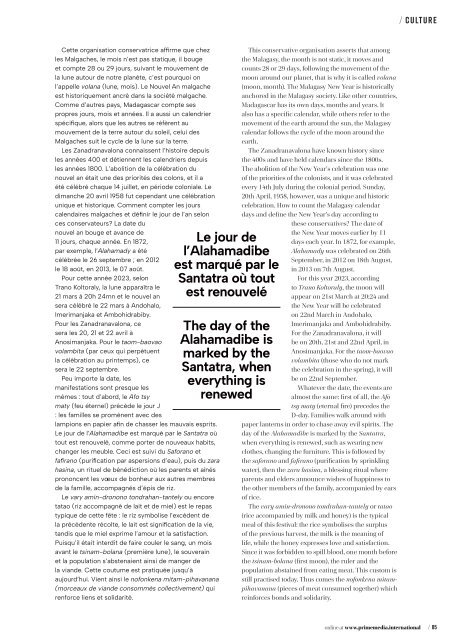Prime Magazine Mars / March 2023
Create successful ePaper yourself
Turn your PDF publications into a flip-book with our unique Google optimized e-Paper software.
culture<br />
Cette organisation conservatrice affirme que chez<br />
les Malgaches, le mois n’est pas statique, il bouge<br />
et compte 28 ou 29 jours, suivant le mouvement de<br />
la lune autour de notre planète, c’est pourquoi on<br />
l’appelle volana (lune, mois). Le Nouvel An malgache<br />
est historiquement ancré dans la société malgache.<br />
Comme d’autres pays, Madagascar compte ses<br />
propres jours, mois et années. Il a aussi un calendrier<br />
spécifique, alors que les autres se réfèrent au<br />
mouvement de la terre autour du soleil, celui des<br />
Malgaches suit le cycle de la lune sur la terre.<br />
Les Zanadranavalona connaissent l’histoire depuis<br />
les années 400 et détiennent les calendriers depuis<br />
les années 1800. L’abolition de la célébration du<br />
nouvel an était une des priorités des colons, et il a<br />
été célébré chaque 14 juillet, en période coloniale. Le<br />
dimanche 20 avril 1958 fut cependant une célébration<br />
unique et historique. Comment compter les jours<br />
calendaires malgaches et définir le jour de l’an selon<br />
ces conservateurs? La date du<br />
nouvel an bouge et avance de<br />
11 jours, chaque année. En 1872,<br />
par exemple, l’Alahamady a été<br />
célébrée le 26 septembre ; en 2012<br />
le 18 août, en 2013, le 07 août.<br />
Pour cette année <strong>2023</strong>, selon<br />
Trano Koltoraly, la lune apparaîtra le<br />
21 mars à 20h 24mn et le nouvel an<br />
sera célébré le 22 mars à Andohalo,<br />
Imerimanjaka et Ambohidrabiby.<br />
Pour les Zanadranavalona, ce<br />
sera les 20, 21 et 22 avril à<br />
Anosimanjaka. Pour le taom-baovao<br />
volambita (par ceux qui perpétuent<br />
la célébration au printemps), ce<br />
sera le 22 septembre.<br />
Peu importe la date, les<br />
manifestations sont presque les<br />
mêmes : tout d’abord, le Afo tsy<br />
maty (feu éternel) précède le jour J<br />
: les familles se promènent avec des<br />
lampions en papier afin de chasser les mauvais esprits.<br />
Le jour de l’Alahamadibe est marqué par le Santatra où<br />
tout est renouvelé, comme porter de nouveaux habits,<br />
changer les meuble. Ceci est suivi du Saforano et<br />
fafirano (purification par aspersions d’eau), puis du zara<br />
hasina, un rituel de bénédiction où les parents et aînés<br />
prononcent les vœux de bonheur aux autres membres<br />
de la famille, accompagnés d’épis de riz.<br />
Le vary amin-dronono tondrahan-tantely ou encore<br />
tatao (riz accompagné de lait et de miel) est le repas<br />
typique de cette fête : le riz symbolise l’excédent de<br />
la précédente récolte, le lait est signification de la vie,<br />
tandis que le miel exprime l’amour et la satisfaction.<br />
Puisqu’il était interdit de faire couler le sang, un mois<br />
avant le tsinam-bolana (première lune), le souverain<br />
et la population s’abstenaient ainsi de manger de<br />
la viande. Cette coutume est pratiquée jusqu’à<br />
aujourd’hui. Vient ainsi le nofonkena mitam-pihavanana<br />
(morceaux de viande consommés collectivement) qui<br />
renforce liens et solidarité.<br />
Le jour de<br />
l’Alahamadibe<br />
est marqué par le<br />
Santatra où tout<br />
est renouvelé<br />
The day of the<br />
Alahamadibe is<br />
marked by the<br />
Santatra, when<br />
everything is<br />
renewed<br />
This conservative organisation asserts that among<br />
the Malagasy, the month is not static, it moves and<br />
counts 28 or 29 days, following the movement of the<br />
moon around our planet, that is why it is called volana<br />
(moon, month). The Malagasy New Year is historically<br />
anchored in the Malagasy society. Like other countries,<br />
Madagascar has its own days, months and years. It<br />
also has a specific calendar, while others refer to the<br />
movement of the earth around the sun, the Malagasy<br />
calendar follows the cycle of the moon around the<br />
earth.<br />
The Zanadranavalona have known history since<br />
the 400s and have held calendars since the 1800s.<br />
The abolition of the New Year's celebration was one<br />
of the priorities of the colonists, and it was celebrated<br />
every 14th July during the colonial period. Sunday,<br />
20th April, 1958, however, was a unique and historic<br />
celebration. How to count the Malagasy calendar<br />
days and define the New Year's day according to<br />
these conservatives? The date of<br />
the New Year moves earlier by 11<br />
days each year. In 1872, for example,<br />
Alahamady was celebrated on 26th<br />
September, in 2012 on 18th August,<br />
in 2013 on 7th August.<br />
For this year <strong>2023</strong>, according<br />
to Trano Koltoraly, the moon will<br />
appear on 21st <strong>March</strong> at 20:24 and<br />
the New Year will be celebrated<br />
on 22nd <strong>March</strong> in Andohalo,<br />
Imerimanjaka and Ambohidrabiby.<br />
For the Zanadranavalona, it will<br />
be on 20th, 21st and 22nd April, in<br />
Anosimanjaka. For the taom-baovao<br />
volambita (those who do not mark<br />
the celebration in the spring), it will<br />
be on 22nd September.<br />
Whatever the date, the events are<br />
almost the same: first of all, the Afo<br />
tsy maty (eternal fire) precedes the<br />
D-day. Families walk around with<br />
paper lanterns in order to chase away evil spirits. The<br />
day of the Alahamadibe is marked by the Santatra,<br />
when everything is renewed, such as wearing new<br />
clothes, changing the furniture. This is followed by<br />
the saforano and fafirano (purification by sprinkling<br />
water), then the zara hasina, a blessing ritual where<br />
parents and elders announce wishes of happiness to<br />
the other members of the family, accompanied by ears<br />
of rice.<br />
The vary amin-dronono tondrahan-tantely or tatao<br />
(rice accompanied by milk and honey) is the typical<br />
meal of this festival: the rice symbolises the surplus<br />
of the previous harvest, the milk is the meaning of<br />
life, while the honey expresses love and satisfaction.<br />
Since it was forbidden to spill blood, one month before<br />
the tsinam-bolana (first moon), the ruler and the<br />
population abstained from eating meat. This custom is<br />
still practised today. Thus comes the nofonkena mitampihavanana<br />
(pieces of meat consumed together) which<br />
reinforces bonds and solidarity.<br />
online at www.primemedia.international / 85
















